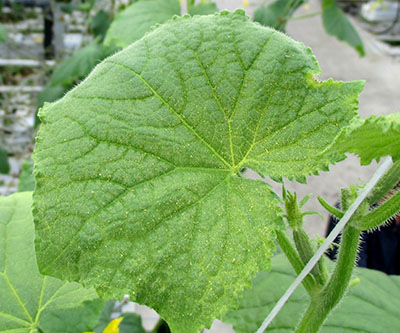Applying pollen over a crop as an alternative food source for predatory mites
Cattail pollen is an effective supplemental food source for predatory mites in some cropping systems. However, the strategy is still debated among scientists.

In order to maintain a successful biological control program, the population of beneficial insects must be adequate through the entire production cycle. If the pest population is too low, there is not enough food for the predators and they may starve and disappear. Banker plants are one way to introduce an alternative food source into a cropping system. Distributing pollen on top of the crop is another method for providing an alternative food source for predatory mites, particularly when growing high-wire vegetables.
In commercial greenhouses, Amblyseius swirskii and A. cucumeris are used for thrips control while A. californicus is used for spider mite control. These predatory mites will eat pollen in food-limiting situations. In order to maintain the predatory mite population, growers can apply pollen via a “pollen gun” to the crop (Photo 1). Cattail (T. latifolia) pollen is commercially available and has been determined to be an excellent food source for A. swirskii. A very light dusting of pollen is sufficient to feed the predatory mites until the population of their prey increases (Photo 2).

Photo 2. Cattail pollen (Nutrimite, Biobest) on a cucumber leaf provides a supplemental food source for predatory mites. Photo credit: Heidi Wollaeger, MSU Extension
Seeking alternatives to cattail pollen, a 2013 study compared 21 different pollen types and their effects on mortality, development time and reproductive rate of A. swirskii. Castor bean (Ricinus communis) or corn (Zea mays) pollen proved to be the most effective as a supplemental food source by introducing them into the cropping system as banker plants. Note: Castor beans contain the extremely poisonous substance ricin.
Pollen from horse chestnut (Aesculus hippocastanum) and silver birch (Betula pendula) trees would be excellent alternatives to cattail pollen to disperse over the crop. Pollen from amaryllis (Hippeastrum sp.) and lilies (Lilium martagon) were deadly to the predatory mites.
Another study published in 2014 examined the effectiveness of three types of pollen (cattail, apple and maize) and the eggs of a Mediterranean flour moth, Ephestia, as a supplemental food source for both A. cucumeris and A. swirskii. For A. cucumeris, apple and cattail pollen were the best (based on survival, development, sex ratio and reproductive rate), while flour moth eggs, cattail pollen and apple pollen were similarly effective for A. swirskii. Maize pollen was less suitable for both of the predatory mites than any of the other alternative food sources tested.
However, dusting crops with pollen is debated among scientists since pollen itself is a food source for pest insects, such as western flower thrips. A 2014 Dutch study showed that distributing pollen on a crop will more effectively increase the population of the predators than the pest population. While western flower thrips reproduction rates did increase with any type of pollen distribution, the overall density of thrips decreased because of the extremely high populations of A. swirskii. Michigan State University Extension recommends discussing pollen distribution with your biocontrol representative prior to adopting it into your biological control program.
If you are a Michigan grower interested in learning more about these biological control strategies, consider attending the Ontario Bus Tour of Floriculture Greenhouse Insect Biocontrol Programs, Oct. 28-30, 2015. More information will be available mid-July on the MSU Extension Floriculture Events page, and registration will open to growers on Aug. 1, 2015. On this tour, we will visit four wholesale greenhouses, one retail garden center and the Vineland Research Station. While the focus of our tour will be implementing an insect biological control program, others topics will include greenhouse automation to save on labor expenses, retail marketing, various greenhouse structures and other production practices.



 Print
Print Email
Email


